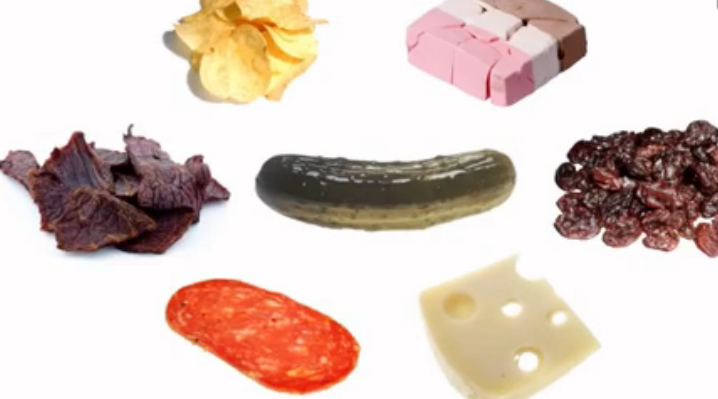冷凍食物二三事
Food is delicious, not to mention kind of important for life. But food also goes bad, so humans have invented many ways to preserve it to eat later or far from where it was harvested. Some of these methods require unhealthy chemicals or degrade the food's nutritional value. But luckily, freezing can preserve food with most of its nutrients, well, frozen in place.
食物很美味,更別說對生命來講有些重要。但食物也會壞掉,所以人類發(fā)明出許多方法來將食物保存起來,好能稍后再吃或在離產(chǎn)地很遠的地方吃。這之中有些方法需要不健康的化學(xué)物質(zhì),或者會降低食物營養(yǎng)價值。不過幸好,冷凍可以將食物和其中多數(shù)營養(yǎng)保存起來,這個嘛,把營養(yǎng)好好地凍起來。
The important part is that most chemical and biological processes run slower at lower temperatures, which means that if you cool food a lot, enzymes and bacteria and fungi in the food get too cold to decompose it. That's why food lasts longer in the freezer than in the fridge than on the counter. Freezing, however, wasn't always an easy task, especially before fridges were invented. It's not that freezing food is a new idea—I mean, people who live in cold places have done it by default for thousands of years. But things got messy when we started creating artificial winter to freeze food in warmer climates.
重要的部分是,大多數(shù)化學(xué)和生物過程在較低的溫度下會進行得比較慢,那就代表如果你將食物大幅冷卻,食物里的酵素和細菌以及真菌就會冷到?jīng)]辦法使食物腐壞。那就是為什么食物在冷凍庫保存得比在冰箱和流理柜上久。然而,冷凍并不一直是一項簡單的任務(wù),特別是在冰箱被發(fā)明出來前。不是說將食物冷凍起來是個新點子--我的意思是,住在寒冷地區(qū)的人們幾千年來就只能這么做。不過當(dāng)我們開始在比較溫暖的氣候里打造人造寒冬來冷凍食物時,事情就變得麻煩了。

Early freezers were basically rooms full of salty ice, which, while they could freeze food, took many hours or even days to do so. A slow freeze gives fluid within cells the time to stack up into big ice crystals. Since water expands when it freezes, the sharp edges of these crystals poke holes through the walls of the cells, and when the food thaws, the fluid leaks out. Gross! Even grosser? Birds' eyes. Clarence Birdseye, to be precise.
早期的冷凍庫基本上是裝滿灑鹽冰塊的房間,那種房間,雖然它們可以冷凍食物,但卻要花上好幾個小時,甚至是好幾天來這樣做。速度緩慢的結(jié)凍過程讓細胞內(nèi)的液體有時間結(jié)成大冰晶。由于水在結(jié)凍時會膨脹,這些結(jié)晶的銳利邊緣會戳破細胞壁,而當(dāng)食物解凍時,那液體就會滲出來。惡!更惡心的?鳥類的眼睛。確切地說,Clarence Birdseye。
An American entrepreneur who lived in Arctic Canada in the nineteen-teens, Birdseye noticed that when Inuit people went ice fishing in minus-40 degree windy conditions, their catch froze almost immediately. When cooked later, the fish tasted fresh. Birdseye realized that the Arctic frozen foods were tasty because they froze quickly and formed smaller ice crystals that didn't damage the cells. Inspired, he went on to develop a process to quickly freeze food by pressing small packages between metal plates chilled to 40 below zero. Combined with clever marketing, this allowed Birdseye to bring Arctic winter to the rest of the world and to almost single-handedly jump-start the modern market for frozen foods.
一位 1913 至 1919 年間居住在加拿大極地的美國創(chuàng)業(yè)家,Birdseye 他注意到當(dāng)因紐特人在負四十度颳風(fēng)的情況下去冰釣時,他們的漁獲幾乎是馬上結(jié)凍。過一陣子被拿來煮時,魚嘗起來很新鮮。Birdseye 發(fā)現(xiàn)北極冷凍食物很好吃,因為它們快速結(jié)凍并形成不會破壞細胞的較小冰晶。受到啟發(fā),他開始研發(fā)能快速冷凍食物的方法,那冷凍方法是靠將一包包小包裹塞進冷凍到零下四十度的金屬板間。結(jié)合聰明的行銷,這讓 Birdseye 得以將北極的冬天帶到世界其它地方,且?guī)缀踔皇珠_啟了現(xiàn)代冷凍食物市場。
You probably even have your own freezer, a marvelous device cold enough to quick-freeze almost any food you put in it. In other words, the North Pole—in your kitchen.
你搞不好甚至有自己的冷凍庫,一個冷到可以快速結(jié)凍幾乎你放進去的任何食物的神奇設(shè)備。換句話說就是,北極--在你家廚房里。












